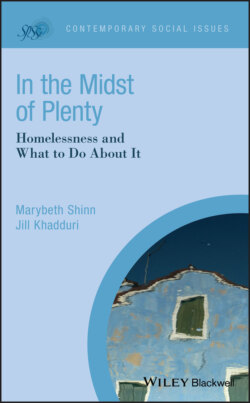In the Midst of Plenty

Реклама. ООО «ЛитРес», ИНН: 7719571260.
Оглавление
Marybeth Shinn. In the Midst of Plenty
Table of Contents
List of Illustrations
Guide
Pages
Contemporary Social Issues
In the Midst of Plenty. Homelessness and What to Do About It
Foreword
Acknowledgments
Introduction
1 Who Becomes Homeless?
Where People Sleep: Definitions of Homelessness
Data Sources
Groups of People Who Experience Literal Homelessness
Families with Children
Adults on Their Own
People with Chronic Patterns of Homelessness
Youth
Veterans
Age, Race, and Gender
Changes Over Time
Total Numbers Over a Day, a Year, or a Lifetime
The Importance of Time Frames
Challenges Faced by People Experiencing Homelessness
Summary
Notes
2 What Causes Homelessness?
Homelessness, Poverty, and Inequality in an International Context
Increasing “Deep Poverty” in the United States
Family Poverty and Antipoverty Programs
Poverty for Childless Adults and Antipoverty Programs
Income Volatility
Wealth
Poverty, Housing, and Homelessness
Evidence from Time Trends
Evidence from Locations where Homelessness is more Prevalent
Evidence from Housing Policies
Cultural Attitudes, Social Welfare Policy, and Social Exclusion
Racism, Social Exclusion, and Homelessness
Income
Wealth
Housing
Incarceration
Mental Illnesses and Other Disabilities
Sexual Orientation and Gender Identity
Other Individual Risk Factors for Homelessness
Social Isolation
Domestic Violence
Bad Luck
Summary
Notes
3 Ending Homelessness for People Who Experience It
Long‐Term Rental Subsidies for Families
Perverse Incentives
Psychosocial Services
Subsidies Plus Voluntary Services for High Needs Individuals
Pathways to Housing
At Home/Chez Soi
Other Approaches for High‐Needs Individuals
Summary
Notes
4 Comprehensive Efforts to End Homelessness
The Homeless Services System
Emergency Shelters
Transitional Housing
Time‐Limited Subsidies: Rapid Re‐Housing
Permanent Supportive Housing
Making the System Work to End Homelessness
Making the System More Efficient and Effective
Focused Efforts to End Chronic Homelessness
Nashville and Los Angeles
Reducing Homelessness for Veterans
The Finnish Model
Summary
Notes
5 Preventing Homelessness for People at Risk
Evaluating Prevention for People at High Risk: Efficiency and Effectiveness
Efficient Allocation of Prevention Services
Evaluating Effectiveness
Programs with Solid Evidence of Effectiveness. Permanent Deep Housing Subsidies
Eviction Prevention: Cash Assistance
Community‐Based Services: New York City's HomeBase
Critical Time Intervention (CTI) for People Discharged from Psychiatric Hospitals
Programs with Suggestive Evidence of Effectiveness. Universal Screening for Veterans
Housing Subsidies with Supportive Services for People with Mental Illnesses
Shallow, Permanent Subsidies
Eviction Prevention: Legal Representation in Housing Courts
Eviction Prevention: Landlord–Tenant Mediation
Programs That Might Be Effective
Extended Resources for Youth Leaving Foster Care
Help for People Reentering the Community from Jails and Prisons
VA‐Like Screening for Other Populations at Risk
Flexible Cash Grants to Low‐Income Households
Bringing Resources to High‐Risk Neighborhoods
Integrating Homelessness and Antipoverty Service Systems
Prevention Programs and Cost Benefit Analyses
Progressive Engagement
Summary
Notes
6 Changing Societal Conditions that Generate Homelessness
Housing
Expanding Housing Vouchers
Less Expensive Housing Subsidies for Poor Renters
Deeper Targeting of Rent Subsidies
Temporary Rent Subsidies
Rent Subsidies Through the Tax System
Housing Subsidies for Particularly Vulnerable Groups
Building Housing for Poor Renters
Incomes
Supporting Work and Earnings
Broad‐Based Transfer Programs
Income Support for Families
Child Care
Income Support for People with Disabilities
Counteracting Income Volatility—Overcoming Bad Luck
Countering Social Exclusion
Tradeoffs and Combinations for Making Housing Affordable
Summary
Finding the Political Will to End Homelessness
Notes
References
Index
WILEY END USER LICENSE AGREEMENT
Отрывок из книги
“Shinn and Khadduri’s new book is a thorough yet concise examination of what we know about the nature and causes of homelessness, and the crucial lessons learned. This critically important work provides a roadmap to restoring basic housing and income security as viable policy options, in the face of our daunting inequality divide that otherwise threatens millions with destitution and homelessness.”
Dennis Culhane, Dana and Andrew Stone Professor of Social Policy, University of Pennsylvania
.....
Among the unaccompanied young people (sheltered and unsheltered), only 11% were children under the age of 18 (4,000 compared to 107,000 children experiencing homelessness in the company of adults (Henry, Mahathey, et al., 2018, pp. 1–3). Overwhelmingly, minor children who experience the literal homelessness reported by HUD do so as part of families.
However, researchers who focus on adolescent homelessness describe the way in which unaccompanied youth experience homelessness as different in kind from that of older adults or of children who are part of families. Instead of sleeping outdoors or going to shelters, young people who have run away or been thrown out by their families often “couch surf” with friends or are in makeshift and, all too often unsafe or exploitative arrangements (Family and Youth Services Bureau, n.d.; Morton, Dworsky, & Samuels, 2017).
.....